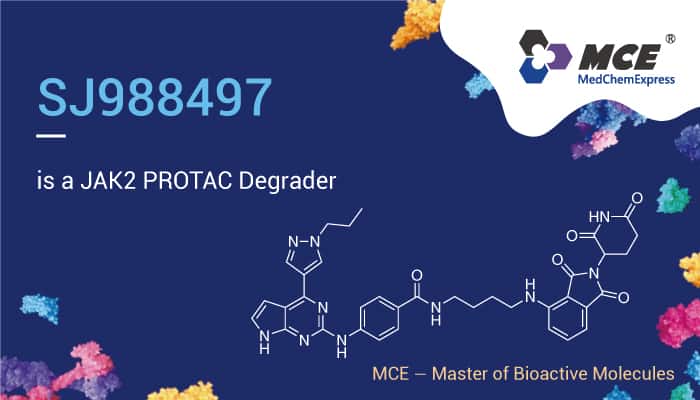Chronic myeloid leukemia (CML) is a kind of myeloproliferative neoplasms (MPN). It is characterized by the proliferation of a pluripotential stem cell that can differentiate along the granulocytic lineage. In terms of mechanism, it is consistently related to the BCR-ABL1 fusion gene. CML is typically relevant to a balanced reciprocal translocation between the long arms of chromosomes 9 and 22 or t(9;22) resulting in a shortened chromosome 22 (Philadelphia chromosome). The Ph chromosome (BCR-ABL fusion gene) consists of the fusion of the 3’ sequences from the ABL1 (Abelson) gene at 9q34 to the 5’ portion of the BCR gene sequences at 22q11. In addition, The product of this fusion BCR-ABL gene is a constitutively active protein tyrosine kinase, p210 BCR-ABL, that promotes cellular proliferation and suppresses apoptosis. Therefore, BCR-ABL kinase activity is critical to the development of CML.
SIAIS100 is a potent BCR-ABL PROTAC degrader with a DC50 value of 2.7 nM.

SIAIS100 exhibits anti-proliferative activity against K562 cells with an IC50 value of 12 nM. It degrades BCR-ABL with degradation ratios of 81.78% and 91.20% at 5 nM and 100 nM, respectively. SIAIS100 (100 nM, 8 h) significantly decreases BCR-ABL in K562 cells. Besides, SIAIS100 (100 nM, 6 h) induced sustained and robust BCR-ABL degradation and maintained a durable cellular response after drug removal. Moreover, SIAIS100 (1-1000 nM) significantly degrades mutation G250E/T315I dose-dependently accompanied by the inhibition of BCR-ABL signaling assessed by the level of p-BCR-ABL in 32D cells.
In conclusion, SIAIS100 is a potent BCR-ABL PROTAC degrader and has the potential to research CML.
References:
1. Liu H, et al. Eur J Med Chem. 2022 Dec 15;244:114810.
2. Ayatollahi H, et al. Caspian J Intern Med. 2018;9(1):65-70.